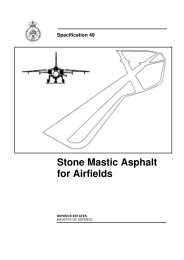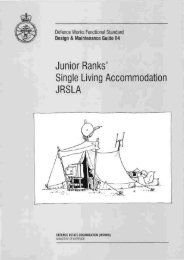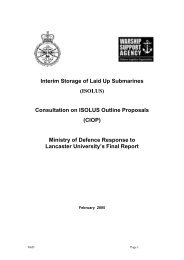Part III - Historical Survey of the Porton Down Service Volunteer ...
Part III - Historical Survey of the Porton Down Service Volunteer ...
Part III - Historical Survey of the Porton Down Service Volunteer ...
You also want an ePaper? Increase the reach of your titles
YUMPU automatically turns print PDFs into web optimized ePapers that Google loves.
The Biology Committee met in June 1953 to discuss <strong>the</strong> lessons that should be drawn from<br />
<strong>the</strong> severe case <strong>of</strong> poisoning and <strong>the</strong> fatality [73]:<br />
• first aid treatment needs to be revised urgently, as <strong>the</strong> Holger-Neilson method <strong>of</strong><br />
artificial respiration cannot be given to men suffering from nerve gas poisoning,<br />
and administering atropine by IV injection is not practicable; <strong>the</strong> secretion <strong>of</strong><br />
mucus in <strong>the</strong> airways needs to be studied, as it complicates <strong>the</strong> use <strong>of</strong> artificial<br />
respiration;<br />
• <strong>the</strong> cough reflex in humans normally clears mucus from <strong>the</strong> airways, but <strong>the</strong><br />
reflex appears to be abolished by nerve gas action. A means should be found <strong>of</strong><br />
restoring <strong>the</strong> cough reflex.<br />
The CDAB accepted <strong>the</strong>se conclusions later in <strong>the</strong> year [74]. In making suggestions for first<br />
aid treatment for nerve gas poisoning in 1952, it was admitted that no-one had anticipated<br />
convulsions being so great as to make atropine injections and artificial respiration "extremely<br />
difficult to perform".<br />
The report <strong>of</strong> <strong>the</strong> main human study [66] during which <strong>the</strong> severe case <strong>of</strong> poisoning and <strong>the</strong><br />
fatality occurred notes that no-one whose ChE inhibition was less than 80% showed any<br />
signs or symptoms <strong>of</strong> systemic GB poisoning. It <strong>the</strong>refore includes a table giving details <strong>of</strong><br />
<strong>the</strong> exposures after which a ChE inhibition <strong>of</strong> greater than 80% was observed. Of <strong>the</strong> 14 men<br />
who had a ChE inhibition <strong>of</strong> over 80%, 7 did not present symptoms that required treatment.<br />
The 14 cases where inhibition exceeded 80% are reproduced below (Table 8.7.) and are all<br />
from 1953.<br />
76<br />
ChE inhibition (%) Dose Details Date <strong>of</strong> Exposure<br />
83 300 mg on bare skin 29 January<br />
94 300 mg on one layer <strong>of</strong> serge 10 February<br />
90 250 mg on one layer <strong>of</strong> serge 16 February<br />
83 250 mg on bare skin 9 March<br />
87 250 mg on bare skin 16 March<br />
81 300 mg on bare skin 23 March<br />
87 200 mg on one layer <strong>of</strong> serge 30 March<br />
87 200 mg on one layer <strong>of</strong> serge 30 March<br />
93 300 mg on one layer <strong>of</strong> serge 22 April<br />
85 300 mg on one layer <strong>of</strong> serge 27 April<br />
94 300 mg on one layer <strong>of</strong> serge 27 April<br />
87 200 mg on layer <strong>of</strong> serge and layer <strong>of</strong> flannel 4 May<br />
82 200 mg on layer <strong>of</strong> serge and layer <strong>of</strong> flannel 6 May<br />
96 200 mg on layer <strong>of</strong> serge and layer <strong>of</strong> flannel 6 May<br />
Table 8.7. Occurrences <strong>of</strong> ChE inhibition <strong>of</strong> more than 80%.









